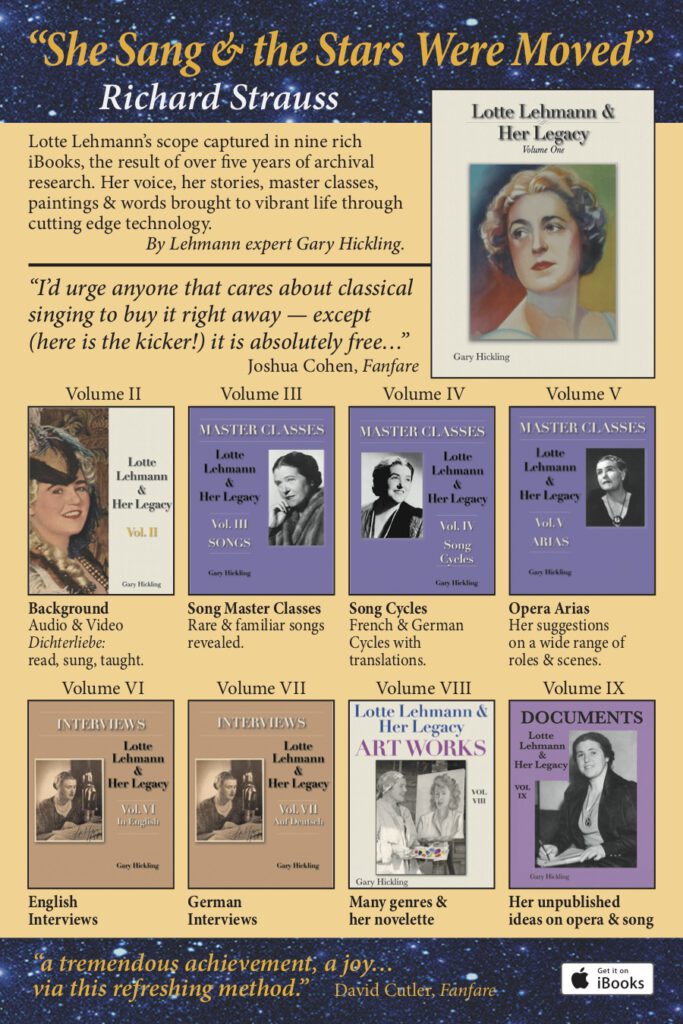Lotte Lehmann & Her Legacy iBooks
With the expert help of Dixon Smith, I worked for over five years on the nine-volume Lotte Lehmann & Her Legacy iBooks series, which we offer at no cost. The unique multimedia Apple iBook format offers an elegant way to access the life and works of Lotte Lehmann, because video clips, recordings, and photos can be embedded in the text to enhance the reading experience. All nine volumes are available free for download here.
Here’s a link to the short tutorial video demonstrating methods of accessing Lotte Lehmann & Her Legacy iBooks. Below, you can find a summary of the contents of each volume, to help you find the material you seek.
Various critics accorded the iBooks high praise in their reviews.
Since one may only download the iBooks if the appropriate Apple device is at hand, I decided to adapt all nine volumes into a web format so it could available to everyone. I tried to recreate the iBook multimedia experience as closely as possible, but there is no tool to convert an iBook into web content. I used many screen captures of pages and page sections taken directly from the iBook; in other cases I copied and pasted text and photos, so you will notice a variety of visual styles.
As a final offering, I created downloadable PDF versions of the whole series available here, but without the audio, video, inserted articles, or galleries.
Fanfare Reviews of 9 Lehmann iBooks
Fanfare magazine has reviewed all nine volumes of my Lotte Lehmann & Her Legacy in Apple Books. You can read their reviews (there are three).

Volume Summaries:
Click on a volume title below or on the sidebar to read the adaptation for the web.
Volume 1 contains recordings of Lehmann singing arias and Lieder, as well as introductions to her artwork, writing, and poetry. There’s a short bio and a complete Winterreise that allows you to enjoy her drawings for each song, hear her read the poetry, listen to her sing the Schubert song, and experience her master classes for each song. There’s a whole chapter on her teaching that include master classes in video and audio formats as well as recordings of her students. You can compare Lehmann’s recordings to her contemporaries in the “Comparisons” chapter. The “Early Recordings” chapter allows you to discover how recordings were made, even before microphones. You’ll find rare Lehmann photos, as well as seven audio tracks not heard since she recorded them. Extensive appendix includes the Lehmann discogrpahy, a list of her roles and song repertoire, and a bibliography.
Volume 2 offers extensions of chapters begun in Volume 1: more rare and recently discovered Lehmann recordings; comparisons (especially with Maria Jeritza); unusual photos; and interleaved commentary on a few arias and Lieder. Dichterliebe is presented with Lehmann’s singing, speaking, and drawings. There’s a chapter on “Her Legendary Marschallin” as well as “Music Academy of the West”. There are more personal chapters: “The Lehmann I Knew” and “The Lehmann Others Knew”. The extensive “Chronology” and “What Critics Wrote” are also included.
Volume 3 provides sound recordings of over a hundred of Lehmann’s master classes of individual art songs, Lieder, mélodie, and even a spiritual. Each song’s master class can be located from the Index by either its title or its composer. Lehmann teaches interpretation not vocal technique. The original poem and English translation is available.
Volume 4 offers Lehmann master classes of art song cycles. Though there are the expected German cycles, it’s amazing to discover how much Lehmann had to offer in the world of the French mélodie cycles by Berlioz, Ravel, and Fauré. Again, you can find the translations.
Volume 5 provides recordings of Lehmann’s master classes of opera arias and opera scenes. Besides her classic roles (the Marschallin, Elsa, Elisabeth, Fidelio, Manon), she teaches operas in which she never sang (Aïda, Un ballo in maschera, Samson et Dalila). The roles that she sang in world or Vienna premiers are represented: Intermezzo, Arabella, and Suor Angelica. The master classes were taught at the Music Academy of the West, Santa Barbara; Wigmore Hall, London; Northwestern University, Chicago; and New England Conservatory of Music, Boston; among others). There are also recordings of private lessons that Lehmann taught at her home. Translations are once again provided.
Volume 6 offers video and audio interviews with Lehmann in English. German interviews can be found in Volume 7. Though not an interview, you will find “An Evening With Lotte Lehmann”, a 30 minute film in which Mme Lehmann introduces her students singing opera scenes.
Volume 7 (German language interviews) enthält Lehmanns Rundfunk – und TV Interviews in deutscher Sprache, ihre Lesungen von Monologen aus Der Rosenkavalier, Gedichte von Goethe, Schiller, und Rilke, sowie ihr eigenes Gedicht. Der ganze Band ist in deutscher Sprache.
Volume 8 provides a glimpse into Lehmann’s art. Gifted as an artist in addition to her singing, teaching, and writing, this series wouldn’t be complete without an attempt to assemble the wide-ranging expressions of her art. For the first time, Of Heaven, Hell, & Hollywood, her 162 type-written satirical novel and its drawings are being published. You’ll also hear Lehmann sing and speak in the chapters on Winterreise, Dichterliebe, and Die schöne Müllerin for which she created drawings for each song.
Volume 9 is called Documents and as such offers a wide scope of Lehmann material. Most importantly, there are suggestions on interpretation of songs and arias in Lehmann’s handwriting or typing. Her letters to former students and fans include copies of the “photo-cards” she mailed. Recently discovered Lehmann photos can be found in a separate chapter. You’ll discover her articles written for American magazines. There are playbills, newspaper notices and historic information on the Lehmann Centennials, books about her, and more. Documents from previous volumes include: Lehmann’s Roles/Song Repertoire; Discography; Bibliography; Chronology; Lehmann’s Of Heaven, Hell, & Hollywood; Lehmann’s conductors; “Lehmann Meets Goering”; “Her Writing”.
